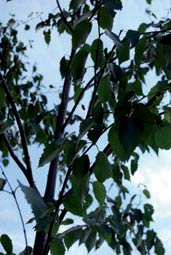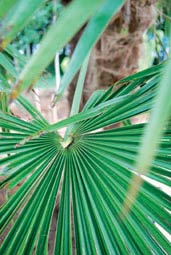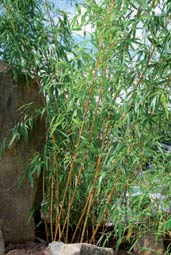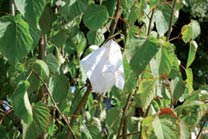
The Plants and Planting
Garden plants in China are inexorably linked to the myths, legends, literature, symbols and the arts of everyday life. The plants are stars on our garden stage. It is a diverse cast and many are familiar characters.
Some of these are 'classic' Chinese plants such as the Maidenhair Tree (Ginkgo biloba) and the Dawn Redwood (Metasequoia glyptostroboides) only re-discovered in 1945. However, there is a great familiarity with many of these plants. Plants that we think of being intrinsically British and part of our garden heritage are in fact of Chinese origin: buddleia, camellia, forsythia, hollyhock, hydrangea, several mahonias, weeping willow and many of the roses and magnolias are in fact Chinese. Even that Victorian stalwart, the aspidistra or cast-iron plant, originates in China. Over two-thirds of garden plants in the UK are of Chinese origin - from the exotic to the everyday such as Hydrangea, Deutzia and Weigela. A general loam soil with a neutral or slightly acid ph level is suitable for the planting.
Due to the ice ages in the North the British environment lost a lot of flora. Many plants were wiped out. However, China did not suffer an ice age and it is to there that many botanical collectors had to look to re-find many previously indigenous plants. This rich diversity is owed to the plant explorers from the late 17th century and particularly to people such as E H 'Chinese' Wilson, George Forrest, Frank Kingdon-Ward, and Reginald Farrer in the late 19th and early 20th centuries. While these British hunters were gathering their specimens, so were collectors from America, France, Germany, Russia, Spain and other countries. Many plants carry names based on their finders such as Spirea wilsonii, Rhododendron wardii, Viburnum farreri. Others were important introductions that carry no obvious hint of their origin such as Paeonia suffruticosa, Davidia involucrata and Meconopsis betonicifolia.
Using botanical names to identify a plant's origin is far from exact, as plants have been exchanged between Japan, China and Korea for centuries. Simple species titles such as sinensis (meaning China), koreana, japonica, or orientalis do not provide a guarantee. Eriobotrya japonica (Loquat) is from central China; Weigela florida is from Korea and China, not Florida; Kerria japonica is from central and western China; Camellia japonica is from China and Japan. Acer palmatum, the Japanese Maple, has been cultivated in China for centuries and its origins are best described as oriental rather than strictly Japan. The strict name is of less importance than the beauty of the plant.
In an English garden, we strive for a range of colours throughout the year, but the Chinese garden is more reflective of the seasons rather than a great floral display. Through summer, it is essentially a green garden. Spring brings the cherry blossom, early summer the peonies followed by hydrangeas. Autumn gives a glorious end prior to the frosts of winter. Plants have been chosen both as representative of Chinese plants (there are over 35,000 Chinese plants), but also for their form and qualities.
Our garden represents a transect of plant communities from northern China to the coastal south. The array of climates gives enormous plant diversity across a country of high mountains, deserts and tropical coastal landscapes. Pinus, Acer, Gingko, various bamboos, Lilium, Ligustrum are indicative of the northern areas, while from the south are plants such as Begonia, Clerodendron, Ficus, and Trachycarpus.
Trees (principally Ginkgo and Pinus) and shrubs (Acers and bamboos) provide the structural control while herbaceous will provide drifts of colour. The colour is be restrained but dramatic - the Chinese garden is one of restricted colour. Chrysanthemums symbolise water running down the mountain to the pond. The tropical end of the garden is essentially a green garden.
Let us just mention a few of our key plants:
Betula alba-sinensis 'Fascination' Chinese Paper Birch: a medium-large tree with orange-red peeling bark making this a particularly stunning tree in the winter. There are a number of cultivars of the original Chinese species. Fascination is one of them.
Davidia involucrata Handkerchief Tree, Ghost Tree or Dove Tree has pairs of large white bracts in the spring, hanging down like two handkerchiefs. It takes many years for these to be produced. Our tree has been hung with handkerchiefs designed with the input of primary school children from Elworth CE Primary.
Ginkgo biloba (Yazhangshu - Duck's Foot Tree) Maidenhair Tree: a tree of 1000 years, the Ginkgo is an oddity-it looks like a broadleaf tree, but is classified as a conifer and is deciduous. Used as a street tree in Shanghai and Beijing, it is an excellent tree here with magnificent autumn colour.
Ilex cornuta (Gougu) Chinese Holly: distinctive with its squarish leaf and its five points, this is a relatively hard plant to find in the UK. Dwarf forms are extremely popular in parts of the USA, particularly the single pointed dwarf Burford Holly.
Morus alba 'Pendula' (Sang) Weeping White Mulberry: the White Mulberry came to Europe in the 15th century and provided the all-important diet for the silkworm and a developing silk industry.
Phyllostachys vivax aureocaulis Green Stripe Bamboo: hardly a garden or park exists within China without some form of bamboo. This one is absolutely hardy and grows as a clump so it can be contained within a section of the garden.
Trachycarpus fortuneii (Zonglu) Chusan Palm: found in central and southern China, this palm is grown for its fibre. It is a good pot plant and the young flowers can be eaten. This one has been outside in Cheshire for several years. One has been growing in Kew since 1849.

Chinese Paper Birch

Chusan Palm

Green Stripe Bamboo

Handkerchief Tree


